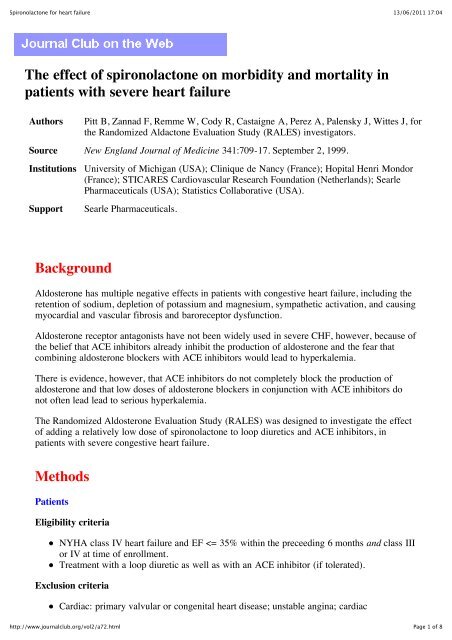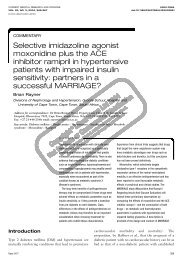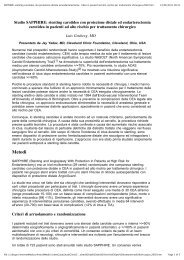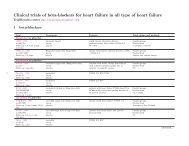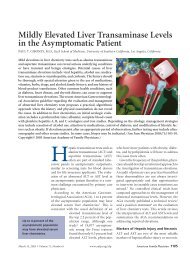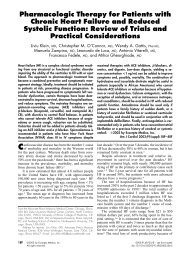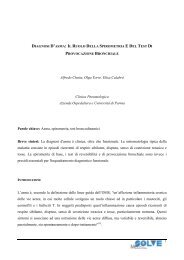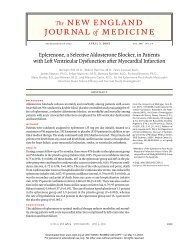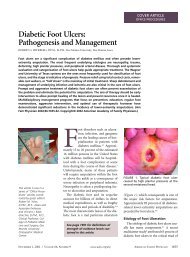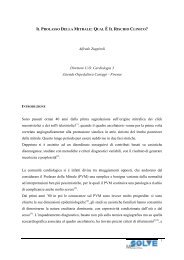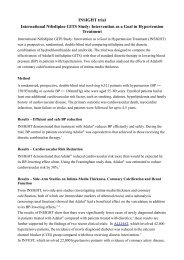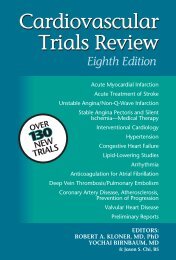Spironolactone for heart failure - Diegori.it
Spironolactone for heart failure - Diegori.it
Spironolactone for heart failure - Diegori.it
You also want an ePaper? Increase the reach of your titles
YUMPU automatically turns print PDFs into web optimized ePapers that Google loves.
<strong>Spironolactone</strong> <strong>for</strong> <strong>heart</strong> <strong>failure</strong>13/06/2011 17:04The effect of spironolactone on morbid<strong>it</strong>y and mortal<strong>it</strong>y inpatients w<strong>it</strong>h severe <strong>heart</strong> <strong>failure</strong>AuthorsP<strong>it</strong>t B, Zannad F, Remme W, Cody R, Castaigne A, Perez A, Palensky J, W<strong>it</strong>tes J, <strong>for</strong>the Randomized Aldactone Evaluation Study (RALES) investigators.Source New England Journal of Medicine 341:709-17. September 2, 1999.Inst<strong>it</strong>utionsSupportUnivers<strong>it</strong>y of Michigan (USA); Clinique de Nancy (France); Hop<strong>it</strong>al Henri Mondor(France); STICARES Cardiovascular Research Foundation (Netherlands); SearlePharmaceuticals (USA); Statistics Collaborative (USA).Searle Pharmaceuticals.BackgroundAldosterone has multiple negative effects in patients w<strong>it</strong>h congestive <strong>heart</strong> <strong>failure</strong>, including theretention of sodium, depletion of potassium and magnesium, sympathetic activation, and causingmyocardial and vascular fibrosis and baroreceptor dysfunction.Aldosterone receptor antagonists have not been widely used in severe CHF, however, because ofthe belief that ACE inhib<strong>it</strong>ors already inhib<strong>it</strong> the production of aldosterone and the fear thatcombining aldosterone blockers w<strong>it</strong>h ACE inhib<strong>it</strong>ors would lead to hyperkalemia.There is evidence, however, that ACE inhib<strong>it</strong>ors do not completely block the production ofaldosterone and that low doses of aldosterone blockers in conjunction w<strong>it</strong>h ACE inhib<strong>it</strong>ors donot often lead lead to serious hyperkalemia.The Randomized Aldosterone Evaluation Study (RALES) was designed to investigate the effectof adding a relatively low dose of spironolactone to loop diuretics and ACE inhib<strong>it</strong>ors, inpatients w<strong>it</strong>h severe congestive <strong>heart</strong> <strong>failure</strong>.MethodsPatientsEligibil<strong>it</strong>y cr<strong>it</strong>eriaNYHA class IV <strong>heart</strong> <strong>failure</strong> and EF
<strong>Spironolactone</strong> <strong>for</strong> <strong>heart</strong> <strong>failure</strong>13/06/2011 17:04transplantation.Potassium > 5.0 mmol/l or creatinine > 2.5 mg/dl.Primary hepatic <strong>failure</strong>; active cancer.Concomm<strong>it</strong>ent therapyTreatment w<strong>it</strong>h dig<strong>it</strong>alis and vasodilators was allowed.Treatment w<strong>it</strong>h potassium sparing diuretics was not perm<strong>it</strong>ted.Potassium supplementation was not recommended unless serum potassium was less than3.5 mmol/l.InterventionPatients were randomized to e<strong>it</strong>her 25 mg of spironolactone daily or placebo. This dose couldbe increased to 50 mg daily after 8 weeks if there was evidence <strong>for</strong> progression of <strong>heart</strong> <strong>failure</strong> inthe absence of hyperkalemia.The dose could be decreased to every other day if hyperkalemia developed, but <strong>it</strong> wasrecommended that the dose of ACE inhib<strong>it</strong>ors be decreased first. Study medication could bew<strong>it</strong>hheld <strong>for</strong> medical reasons, including hyperkalemia or creatinine > 4.0 mg/dl.Follow-upClinical and laboratory evaluation were carried out every four weeks <strong>for</strong> the first twelve weeks,every 3 months <strong>for</strong> the rest of the first year and every 6 months thereafter. An add<strong>it</strong>ional serumpotassium measurement was per<strong>for</strong>med at 9 weeks in those patients in whom the dose wasincreased at 8 weeks.AnalysisThe primary endpoint was all-cause mortal<strong>it</strong>y, analyzed by intention to treat.Secondary endpoints included cardiac mortal<strong>it</strong>y, hosp<strong>it</strong>alization <strong>for</strong> cardiac causes, death orhosp<strong>it</strong>alization <strong>for</strong> cardiac causes and change in NYHA class.Predefined subgroups <strong>for</strong> analysis of efficacy were ejection fraction, cause of <strong>heart</strong> <strong>failure</strong>,serum creatinine, age, use of ACE inhib<strong>it</strong>or and digoxin.ResultsPatientsA total of 1663 patients from 195 centers were randomized (822 to spironolactone, 841 toplacebo), between March 24, 1995 and December 31, 1996. Analysis was terminated on August24, 1998 (16 months early) after interim analysis demonstrated efficacy of the study drugexceeding preset lim<strong>it</strong>s.http://www.journalclub.org/vol2/a72.htmlPage 2 of 8
<strong>Spironolactone</strong> <strong>for</strong> <strong>heart</strong> <strong>failure</strong>13/06/2011 17:04The groups were well matched at baseline. Pertinent characteristics included (approximateaverage of both groups, unless otherwise indicated):Age 65; wh<strong>it</strong>e 86%; male 73%BP 122/75; <strong>heart</strong> rate 81NYHAClass III: placebo - 69%; spironolactone - 72% (not significantly different)Class IV: placebo - 31%; spironolactone - 27% (nsd)LV ejection fraction: 25.5%; cause of CHF ischemic in 55%MedicationsAll were on loop diuretics95% were on an ACEI. Mean dose of captopril was 62 mg, of enalapril 15 mg, oflisinopril 14 mg.Dig<strong>it</strong>alis 74%Aspirin 37%Beta blockers 10%Potassium supplements 28%Discontinuation of treatment occurred in 200 patients in the placebo group and in 214 in thespironolactone group (<strong>for</strong> lack of response, adverse effects or administrative reasons).Mean follow-up was 24 months.SurvivalCause of death <strong>Spironolactone</strong> Placebo RR and P-valueAll-cause 284 (35%) 386 (46%) 0.70; p 1.2 mg/dl), use of dig<strong>it</strong>alis, use of ACEI, sex, median serum potassium (< or > 4.2 mmol/l),NYHA class (III or IV), beta-blocker use, and use of potassium supplements.Hosp<strong>it</strong>alizationA total of 336 patients in the placebo group (40%) were hosp<strong>it</strong>alized <strong>for</strong> cardiac causes, vs. 260in the spironolactone group (32%), <strong>for</strong> a RR of 0.70 (p
<strong>Spironolactone</strong> <strong>for</strong> <strong>heart</strong> <strong>failure</strong>13/06/2011 17:04NYHA classChange in NYHA class Placebo <strong>Spironolactone</strong>Improved 33% 41%Same 18% 21%Worsened or died 48% 38%Adverse effectsDuring the course of the study, the <strong>heart</strong> rate, blood pressure, weight and serum sodiumconcentrations did not differ between the two groups.In the spironolactone group, the median potassium concentration rose by 0.3 mmol/l and theserum creatinine rose by approximately 0.1 mg/dl. There was no change in the placebo group.Overall, adverse events were reported in 79% of patients taking placebo and in 82% of those onspironolactone. Discontinuation because of adverse events occurred in only 5% of placebopatients and 8% of spironolactone patients. Most of the adverse events occurred w<strong>it</strong>h equalfrequency in both groups, including serious hyperkalemia (10 patients in the placebo group, 14in the spironolactone group).The only adverse effect which happened significantly more often in patients in thespironolactone group was gynecomastia or breast pain, which occurred in 10% of men in thisgroup, vs 1% in the placebo group.Author's discussionThe authors note that the beneficial effects of spironolactone on morbid<strong>it</strong>y and mortal<strong>it</strong>ydemonstrated in this study were observed after 2 to 3 months of treatment and persistedthroughout the study.Recent research has shown that aldosterone can cause myocardial and vascular fibrosis, directvascular damage, baroreceptor dysfunction and can prevent the uptake of norepinephrine by themyocardium. The authors speculate that the beneficial effects of aldosterone receptor blockadeon progressive <strong>heart</strong> <strong>failure</strong> and sudden death are in part due to blocking these effects ofaldosterone. The beneficial effects were seen in patients who were almost all receiving ACEinhib<strong>it</strong>ors; this implies that the reduction of aldosterone production by blockade of theangiotensin system alone is not sufficient to prevent the ill effects of aldosterone in <strong>heart</strong> <strong>failure</strong>.Although some of the effects of spironolactone could be due to natriuresis and retention ofpotassium, the authors point out that there was no evidence of a significant hemodynamic effectof spironolactone and they do not consider the rise in serum potassium in spironolactone treatedpatients to be clinically significant.Significant hyperkalemia was rare, which the authors attribute to the relatively low dose ofspironolactone used (mean dose 26 mg) and to the exclusion of patients w<strong>it</strong>h elevated serumhttp://www.journalclub.org/vol2/a72.htmlPage 4 of 8
<strong>Spironolactone</strong> <strong>for</strong> <strong>heart</strong> <strong>failure</strong>13/06/2011 17:04creatinine or potassium at baseline. Although gynecomastia and breast pain were significantproblems in men treated w<strong>it</strong>h spironolactone, they only led to discontinuation of the drug in 2%of men and may well be a much lesser problem w<strong>it</strong>h newer aldosterone receptor blockers thatare under investigation.CommentThis study of spironolactone in patients w<strong>it</strong>h severe congestive <strong>heart</strong> <strong>failure</strong> revealed a significantreduction (by about 30% relative risk) in death and hosp<strong>it</strong>alizations among treated patients. Thesepatients were receiving reasonable therapy w<strong>it</strong>h diuretics, ACE inhib<strong>it</strong>ors and dig<strong>it</strong>alis, and, althoughonly 10% were on beta-blockers, the benef<strong>it</strong> was, if anything, greater in this subgroup. The results ofthe study should be applicable to a fairly large segment of patients w<strong>it</strong>h severe CHF, since theexclusion cr<strong>it</strong>eria should not rule out the major<strong>it</strong>y of patients in clinical practice.The authors do not state whether or not baseline aldosterone levels were obtained in these patients. Ifthey were, <strong>it</strong> would be interesting to see whether the benef<strong>it</strong> of spironolactone was concentrated inpatients w<strong>it</strong>h higher aldosterone levels. If so, the drug could be targetted to those who would benef<strong>it</strong>the most.I was in<strong>it</strong>ially surprised to see a major pharmaceutical company like Searle sponsoring a trial of suchan old drug, but Searle is also developing a newer aldosterone receptor blocker, eplerenone, whichmay cause less gynecomastia. Whether or not this newer drug will be as effective in CHF remains tobe seen.September 7, 1999ReferencesReferences related to this article from the NLM's PubMed database.Reader CommentsSeptember 12, 1999From: Hans Liedholm [Hans.Liedholm@smi.mas.lu.se]Dear Michael,We read w<strong>it</strong>h interest the publication of the results of the RALES study as this adds to the knowledgeon the pharmacological treatment of severe <strong>heart</strong><strong>failure</strong> (1). Earlier this year two trials on treatmentw<strong>it</strong>h selective beta-blockers were published (2,3). Bisoprolol (CIBIS- II study) and metoprolol(MERIT-HF trial) respectively showed a significant effect on mortal<strong>it</strong>y compared to placebo whenadded to conventional treatment. The impact of the results of these trials is considerable and willhttp://www.journalclub.org/vol2/a72.htmlPage 5 of 8
<strong>Spironolactone</strong> <strong>for</strong> <strong>heart</strong> <strong>failure</strong>13/06/2011 17:04basically change our treatment of (systolic) <strong>heart</strong> <strong>failure</strong>.We want to make two points. Firstly, none of these trials has been properly reported according to theCONSORT guidelines <strong>for</strong> reports of randomised controlled trials (4). How many patients werein<strong>it</strong>ially involved and from where did they come? The omission of in<strong>for</strong>mation on eligible patients ishard to understand, as the external valid<strong>it</strong>y depends on the representativ<strong>it</strong>y of included patients.Secondly, <strong>it</strong> would be clarifying if all major trials also reported the NNTs (w<strong>it</strong>h 95 % confidenceintervals).Yours Sincerely,Hans Liedholm, MD PhD, Agneta Björck Linné, B PharmThe Drugs and Therapeutics Comm<strong>it</strong>tee, Malmö Univers<strong>it</strong>y Hosp<strong>it</strong>al, S-205 02 Malmö, Sweden.hans.liedholm@smi.mas.lu.se1. P<strong>it</strong>t B, Zannad F, Remme WJ, Cody R, Castaigne A, Perez A, Palensky J, W<strong>it</strong>tes J, <strong>for</strong> theRandomized Aldactone Evaluation Study Investigators. The effect of spironolactone on morbid<strong>it</strong>y andmortal<strong>it</strong>y in patients w<strong>it</strong>h severe <strong>heart</strong> <strong>failure</strong>. N Engl J Med 1999;341: 709-17.2. CIBIS-II Investigators. The Cardiac Insufficiency Bisoprolol Study II (CIBIS-II): a randomisedtrial. Lancet 1999;353:9-13.3. MERIT-HF Study Group. Effect of metoprolol CR/XL in chronic <strong>heart</strong> <strong>failure</strong>: Metoprolol CR/XLrandomised intervention trial in congestive <strong>heart</strong> <strong>failure</strong> (MERIT-HF). Lancet 1999;353:2001-7.4. Altman DG. Better reporting of randomised controlled trials: the CONSORT statement. BMJ1996;313:570-1.Date: September 22, 1999From: Sergio Emanuel Kaiser [kaiser@trip.com.br]In the latest issue of Circulation (Circ 1999;100:1311) the SOLVD investigators published arestrospective analysis addressing the relationship between use of diuretics and arrhythmic deaths.The relative risks of deaths according to the class of diuretic used is shown below. The influence ofnon-potassium sparing diuretics was independent of group assignment, i.e., enalapril or placebo.Relative risk of arrhythmic death according to diuretic use in the SOLVDpopulationNo diuretic 1.00Any diuretic 1.37 (1.08–1.73) p=0.009Non–potassium-sparing diuretic 1.33 (1.05–1.69) p=0.02Potassium-sparing diuretic 0.90 (0.61–1.31) 0.6There<strong>for</strong>e, <strong>it</strong> is possible that part of the mortal<strong>it</strong>y reduction observed in the RALES study could beattributed to the potassium-sparing action of spironolactone.I also have some doubts whether we might extrapolate the RALES results to a larger population underbeta-blocker use, since only 10% were effectively taking such drugs. Nowadays, the use of betablockersin <strong>heart</strong> <strong>failure</strong> is consistently increasing and <strong>it</strong> remains to be proved whether spironolactoneadds incremental benef<strong>it</strong> beyond that of a combination of ACEI and beta-blocker to standard dig<strong>it</strong>alishttp://www.journalclub.org/vol2/a72.htmlPage 6 of 8
<strong>Spironolactone</strong> <strong>for</strong> <strong>heart</strong> <strong>failure</strong>13/06/2011 17:04and diuretic therapy.Best regardsSergio Kaiser, MDThese are important points. The SOLVD study looked at the benef<strong>it</strong> of enalapril inpatients w<strong>it</strong>h CHF. The article referred to by Dr. Kaiser is a retrospective study ofpatients enrolled in SOLVD and found that use of non-potassium sparing diuretics, butnot potassium-sparing diuretics, was associated w<strong>it</strong>h an increased risk of arrhythmicdeath. Un<strong>for</strong>tunately, the exact type of potassium-sparing diuretics was not specified, so<strong>it</strong> is impossible to know whether the major<strong>it</strong>y of patients taking potassium-sparingdiuretics were taking spironolactone or triamterene (not an aldosterone antagonist).If most of these patients were taking spironolactone, then much of the benef<strong>it</strong> seen in thissubgroup in SOLVD might actually be due to aldosterone antagonism (as hypothesizedhere, in RALES), rather than to the prevention of potassium depletion. If, on the otherhand, a significant benef<strong>it</strong> was also present in patients taking triamterene, then one wouldhave to postulate a beneficial effect simply due to the prevention of potassium loss.Prevention of potassium loss alone, however, probably does not account <strong>for</strong> all of thebenef<strong>it</strong> seen in RALES, since an effect was seen on death from progressive CHF also, notonly from arrhythmia.As <strong>for</strong> beta-blockers and aldosterone antagonism, a beneficial effect of spironolactonewas also seen in the subgroup of patients taking beta-blockers, but as you point out, thisrepresents only 10% of the study population. --mjDate: November 11, 1999From: Agostino Colli [agcolli@tin.<strong>it</strong>]In RALES the number of patients in atrial fibrillation is not stated. Evenif one could suppose <strong>it</strong> from the number of patients on dig<strong>it</strong>alis ( 70%)which is just the same in both groups, balancing w<strong>it</strong>h respect to thisfeature is not shown.It is true that the number of patients in atrial fibrillation was not specified. Presumablydig<strong>it</strong>alis was given <strong>for</strong> <strong>heart</strong> <strong>failure</strong>, not <strong>for</strong> fibrillation, in the major<strong>it</strong>y of patients studiedhere. However, I'm not sure that spironolactone would be likely to have more or less ofan effect in patients in fibrillation, so even if the groups were unbalanced in this regard, Idon't think <strong>it</strong> would have affected the outcome. -- mjJanuary 24, 2000From: Javier Ena (jena@san.gva.es)Received: November 30, 1999I read w<strong>it</strong>h great interest your article and I was surprised by the large proportion of patients thatdropped out from study (24% in the placebo group and 26% in the spironolactone group). Could youdetail in numbers the reasons <strong>for</strong> the drop-outs. In add<strong>it</strong>ion, there is some less degree of cardiac<strong>failure</strong> in patients taking spironolactone (27% in class IV in the spironolactone group; 31% in class IVhttp://www.journalclub.org/vol2/a72.htmlPage 7 of 8
<strong>Spironolactone</strong> <strong>for</strong> <strong>heart</strong> <strong>failure</strong>13/06/2011 17:04in the placebo group). Were the differences in mortal<strong>it</strong>y and hosp<strong>it</strong>alization maintained aftercontrolling <strong>for</strong> NYHA class?. Thanks <strong>for</strong> your answer.J. Ena MD (Alicante. Spain)As you note, about one quarter of patients dropped out during the course of the study.The authors do not detail the reasons <strong>for</strong> dropping out, other than to say <strong>it</strong> was "becauseof a lack of response, because of adverse events, or <strong>for</strong> administrative reasons". Thesepatients were included in the analysis of the results.Although there were slightly more patients in severe CHF in the placebo group, thereduction in mortal<strong>it</strong>y was almost identical when subgroups according to NYHA classwere looked at. -- mjJanuary 24, 2000Letters to the Ed<strong>it</strong>or about this article, from the January 13 New England Journal of Medicine.Topics covered include:Was conventional therapy maximized?Danger of hyperkalemia in diabeticsDanger of hyperkalemia in the geriatric populationRole of the beta-adrenergic systemSubm<strong>it</strong> a commentJournal Club homepagehttp://www.journalclub.org/vol2/a72.htmlPage 8 of 8


